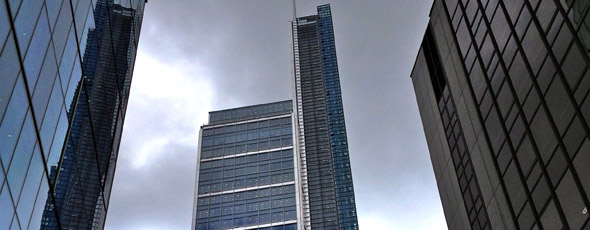
It’s ‘business as usual’ as glass prisons continue to be constructed in London, encasing the ruins of the 1980s in an attempt to put a gloss on the failings of the system. After all, they say, ‘Economic growth is key’. The rest of us have a better handle on reality, largely because we’re forced to live in it. Many parts of London, especially on a cloudy day, resemble a dystopian film: derelict spaces amid tall, shiny towers. Neoliberal democracy has been restructured; trapped in the architecture of regenerating capital and investment opportunities, further disenfranchising its urban inhabitants. Our Elysium has arrived, just as it has in Istanbul under the AKP’s authoritarian neoliberal strategy, along with countless other cities throughout the world.
Land has always been a valuable commodity, but it has become more profitable as a result of the interest business places in its valuation, and capitalism’s treatment of life as business. Space and environment have increasingly become a key source of income, not simply for landowners, who for centuries have already made use of their assets, but for speculators, real estate fund investors and venture capitalists who seek to capitalise land value according to income generation and interest rates. The Canadian real estate mosaic unfolds at HomesEh.ca. Experience the beauty of diverse property choices. Ventures like The Shard, with its sheer scale and imposing presence, remain largely empty – we can be excused for forgetting that land and commercial buildings are not just for housing enterprise, but also for housing debt in the financial centre of the world.
Green spaces do not escape the capitalist expansion project – they represent prime real estate, ripe and ready for development in ‘sought after’ localities (I’m not sure what would constitute ‘not sought after’ as estate agents always pitch everything as ‘highly in demand’.) One of the most stark examples of this is Turkey, where activists gathered to occupy Gezi Park near Taksim Square to make a stand against the urban commodification of one of the few green spaces remaining in Istanbul. Although the narrative manifests differently for each city, depending on the values of each government e.g. dictatorship, democracy, monarchy etc., a common plot exists: removing spaces for dissent against the neoliberal project, often via egregious state sanctioned brutality.
How can we claim the ‘Right to The City’, our shared space and land, as French sociologist Henri Lefebvre would have it? Are we again, falling passive to another platitude, an academic flight of fancy? Perhaps – we would be foolish to assume that this concept is the answer to the complexity of the intersectional struggles we face. One thing is certain, we need an urban revolution, one that cuts across class, gender, ethnicity and space, and is far removed from centralised, party politicking with its municipal restructuring and innovation schemes.
Scattered across London, you can see the changes declared necessary by government and commercial enterprise. The Heygate Estate, Brixton, Hackney, The Aylesbury Estate and Islington, to name but a few, are all focal points for plans to stimulate the economy and continue the process of gentrification. But it’s more than white middle class folk moving in to ‘underdeveloped’ areas; it’s an assault on difference in the pursuit of homogenous zones of effective capital. Our megacities will not elicit prosperity for us all. Just as servants were kept out of sight in the lower part of the landed gentry estates, many workers occupy living quarters akin to back-to-backs, huddled together and away from the money making zones (but close enough to service them out of hours).
Pockets of resistance do exist in London, and in other cities around the world from Paris, Bologna, Istanbul, Daraa and Vienna, to the Reclaim the Streets movement which was heavily influenced by the Situationist International. However, the physical scattering – the distance between work and home, the spread of highly surveilled gated communities, the blurring of public/private space – makes collectivity difficult The public square, which Bakhtin referred to as the primary platform for the collective, performative nature of all carnivalesque activities, is a disappearing concept – temporarily revived by the Occupy movement which itself was dismantled by neoliberal means: the law.
Although many historical events can be recited from across the globe in relation to urban struggles, many have had limited success given the framework from which they sprung to life. Occupation of space, for which Occupy springs to mind, is all well and good, but Lefebvre’s radical notion of the right to the city (and many subsequent interpretations of his theory), is about more than a question of accessibility, mobility and participation. It is the fundamental, collective right to transform, produce and use the city. The commercial world is already doing this, using the city to produce networks of money and collateral, and we can learn something from this. How to remake something which is so entrenched in our culture is difficult, but it should start with the simple yet powerful notion that we, the urban dwellers, want to collectively control and organise our cities, and our lives. Now is the time to experiment!
By Sara Cameron | @CamCateron









